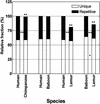Analysis of primate genomic variation reveals a repeat-driven expansion of the human genome
- PMID: 12618366
- PMCID: PMC430288
- DOI: 10.1101/gr.923303
Analysis of primate genomic variation reveals a repeat-driven expansion of the human genome
Abstract
We performed a detailed analysis of both single-nucleotide and large insertion/deletion events based on large-scale comparison of 10.6 Mb of genomic sequence from lemur, baboon, and chimpanzee to human. Using a human genomic reference, optimal global alignments were constructed from large (>50-kb) genomic sequence clones. These alignments were examined for the pattern, frequency, and nature of mutational events. Whereas rates of single-nucleotide substitution remain relatively constant (1-2 x 10(-9) substitutions/site/year), rates of retrotransposition vary radically among different primate lineages. These differences have lead to a 15%-20% expansion of human genome size over the last 50 million years of primate evolution, 90% of it due to new retroposon insertions. Orthologous comparisons with the chimpanzee suggest that the human genome continues to significantly expand due to shifts in retrotransposition activity. Assuming that the primate genome sequence we have sampled is representative, we estimate that human euchromatin has expanded 30 Mb and 550 Mb compared to the primate genomes of chimpanzee and lemur, respectively.
Figures



Similar articles
-
Comparative analysis of Alu repeats in primate genomes.Genome Res. 2009 May;19(5):876-85. doi: 10.1101/gr.083972.108. Genome Res. 2009. PMID: 19411604 Free PMC article.
-
A non-human primate BAC resource to study interchromosomal segmental duplications.Cytogenet Genome Res. 2009;125(4):253-9. doi: 10.1159/000235930. Epub 2009 Oct 27. Cytogenet Genome Res. 2009. PMID: 19864887
-
Characterization of a novel class of interspersed LTR elements in primate genomes: structure, genomic distribution, and evolution.J Mol Evol. 1998 Jun;46(6):649-60. doi: 10.1007/pl00006345. J Mol Evol. 1998. PMID: 9608047
-
Primate comparative genomics: lemur biology and evolution.Trends Genet. 2007 Apr;23(4):173-82. doi: 10.1016/j.tig.2007.02.007. Epub 2007 Feb 27. Trends Genet. 2007. PMID: 17331617 Review.
-
Sequencing primate genomes: what have we learned?Annu Rev Genomics Hum Genet. 2009;10:355-86. doi: 10.1146/annurev.genom.9.081307.164420. Annu Rev Genomics Hum Genet. 2009. PMID: 19630567 Free PMC article. Review.
Cited by
-
Emergence of young human genes after a burst of retroposition in primates.PLoS Biol. 2005 Nov;3(11):e357. doi: 10.1371/journal.pbio.0030357. Epub 2005 Oct 11. PLoS Biol. 2005. PMID: 16201836 Free PMC article.
-
Identification of large-scale human-specific copy number differences by inter-species array comparative genomic hybridization.Hum Genet. 2006 Mar;119(1-2):185-98. doi: 10.1007/s00439-005-0130-9. Epub 2006 Jan 5. Hum Genet. 2006. PMID: 16395594
-
Comparative analysis of the primate X-inactivation center region and reconstruction of the ancestral primate XIST locus.Genome Res. 2011 Jun;21(6):850-62. doi: 10.1101/gr.111849.110. Epub 2011 Apr 25. Genome Res. 2011. PMID: 21518738 Free PMC article.
-
LINEs and SINEs of primate evolution.Evol Anthropol. 2010 Nov 1;19(6):236-249. doi: 10.1002/evan.20283. Evol Anthropol. 2010. PMID: 25147443 Free PMC article. No abstract available.
-
Increased mutation and gene conversion within human segmental duplications.Nature. 2023 May;617(7960):325-334. doi: 10.1038/s41586-023-05895-y. Epub 2023 May 10. Nature. 2023. PMID: 37165237 Free PMC article.
References
-
- Alkan C., Tuzun, E., Eicher, E.E., Bailey, J.A., and Sahinalp, S.C., 2002. MaM: Multiple alignment manipulator. In Currents in computational molecular biology 2002., pp. 3–4. Celera Genomics, Rockville, MD.
-
- Aparicio S., Chapman, J., Stupka, E., Putnam, N., Chia, J.M., Dehal, P., Christoffels, A., Rash, S., Hoon, S., Smit, A., et al. 2002. Whole-genome shotgun assembly and analysis of the genome of Fugu rubripes. Science 297: 1301-1310. - PubMed
-
- Bailey J.A., Gu, Z., Clark, R.A., Reinert, K., Samonte, R.V., Schwartz, S., Adams, M.D., Myers, E.W., Li, P.W., and Eichler, E.E. 2002. Recent segmental duplications in the human genome. Science 297: 1003-1007. - PubMed
-
- Bailey W.J., Fitch, D.H., Tagle, D.A., Czelusniak, J., Slightom, J.L., and Goodman, M. 1991. Molecular evolution of the ψ η-globin gene locus: Gibbon phylogeny and the hominoid slowdown. Mol. Biol. Evol. 8: 155-184. - PubMed
-
- Batzer M.A. and Deininger, P.L. 2002. Alu repeats and human genomic diversity. Nat. Rev. Genet. 3: 370-379. - PubMed
Publication types
MeSH terms
Substances
Grants and funding
LinkOut - more resources
Full Text Sources
Miscellaneous
